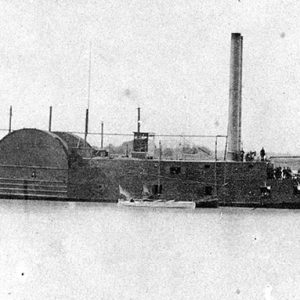calsfoundation@cals.org
USS Lexington
The USS Lexington was a timberclad city-class gunboat in the U.S. Navy that saw extensive service on the Mississippi River and tributaries within Arkansas during the Civil War. It was the third vessel in the history of the navy to be commissioned with this name.
Built as a side-wheel steamer in Pittsburgh, Pennsylvania, in 1861 and purchased by the U.S. Quartermaster Department on June 8 for conversion to a gunboat in Cincinnati, Ohio, the USS Lexington measured 177 feet and seven inches in length and thirty-six feet and ten inches at the beam. It weighed 448 tons and made seven knots with a battery of one twelve-pounder howitzer, four eight-inch guns, and one thirty-two-pounder and two thirty-pounder Parrott rifles.
Under Commander John Rodgers, the Lexington joined the Western Gunboat Flotilla at Cairo, Illinois, on August 12, 1861. On August 22, under Commander Roger Nelson Stembel, the Lexington saw its first significant action when it seized the Confederate steamer the W. B. Terry at Paducah, Kentucky.
While serving with the USS Tyler on September 4, 1861, the Lexington engaged the CSS Yankee (a.k.a. CSS Jackson) and Confederate shore batteries near Hickman and Columbus, Kentucky. Two days later, the Lexington and the Tyler combined to support Brigadier General Ulysses S. Grant’s seizure of Paducah and Smithland, Kentucky, on the Tennessee and Cumberland rivers. Through September and October 1861, Lexington engaged in operations in Kentucky and Missouri, including Grant’s movement against Belmont, Missouri.
By February 1862, the Lexington rejoined the Western Flotilla, operating frequently with the Tyler and the USS Conestoga on the Tennessee River. On February 8, 1862, these ships captured the CSS Muscle and the CSS Sallie Wood. The Lexington also served with distinction in the battles of Fort Henry and Fort Donelson. Afterward, these ships continued to patrol the Tennessee River to protect Union transports and guard against passage by Confederate transports.
In April, the Lexington provided protective fire at the Battle of Shiloh, which helped make possible Grant’s successful counterattack. On June 14, 1862, the Lexington moved into Arkansas and up the White River with the Conestoga, the USS St. Louis, and the USS Mound City, where they joined the attack on St. Charles (Arkansas County). During this action, crewmen from the USS Mound City who were scalded when a Confederate shell exploded in its steam drum received treatment on the Lexington.
Beginning in October 1862, the Lexington supported operations on the Yazoo River in Mississippi. On December 27 and 28, it cleared mines from the river and provided support fire for Union troops during the Battle of Chickasaw Bluffs.
On January 4, 1863, the Lexington and the gunboat flotilla shelled Fort Hindman on the White River, forcing Confederates to withdraw from positions along the White and Arkansas rivers. On January 25, the Lexington supported Major General William Rosecrans’s operations along the Cumberland River. On February 3, the Lexington helped defend Fort Donelson in Tennessee.
On June 2, the Lexington returned to the Mississippi River to support Grant’s final campaign against Vicksburg, Mississippi. Teaming with the USS Choctaw, the Lexington provided fire support for troops engaged at the Battle of Milliken’s Bend, Mississippi. Thereafter, the Lexington supported operations against Vicksburg until that city’s surrender on July 4. For the remainder of 1863, the Lexington supported Major General William Tecumseh Sherman’s operations.
Between February and March 1864, the Lexington patrolled the Black and Ouachita rivers and Bayou Louis, capturing artillery and cotton. On March 15, 1864, in conjunction with the USS Ouachita and the USS Eastport, the Lexington moved against Alexandria, Louisiana, forcing six Confederate steamers to escape over the Alexandria Rapids (and forcing the CSS Countess to be burned to prevent capture). Union forces captured Alexandria the next day. On April 7, 1864, the Lexington and five other gunboats went over the rapids to support Major General Nathaniel Banks during the Red River Campaign. With Banks’s expedition in retreat and the fleet blocked by sunken obstructions near Springfield Landing, Louisiana, the Lexington provided protective fire against Confederate infantry and cavalry on April 10. On May 9, Lieutenant Colonel Joseph Bailey’s dam-building project raised water levels sufficiently to allow the Lexington and the fleet to escape.
On June 15, 1864, the Lexington seized the Confederate steamers the Mattie, the M. Walt, and the R. E. Hill at Beulah Landing, Mississippi, and seized another shipment of cotton. On June 22, 1864, the Lexington repulsed an attack on White River Station.
The Lexington performed patrol and convoy duty for the remainder of the war. On June 5, 1865, the Lexington sailed north on the Mississippi River to Mound City, Illinois. Decommissioned on July 2, 1865, it was sold to the firm of Thomas Scott and Woodburn on August 17, 1865.
For additional information:
Gaines, W. Craig. Encyclopedia of Civil War Shipwrecks. Baton Rouge: Louisiana State University Press, 2008.
Gibson, Charles Dana, and E. Kay Gibson. Dictionary of Transports and Combatant Vessels, Steam and Sail, Employed by the Union Army, 1861–1868. Camden, ME: Ensign Press, 1995.
Konstam, Augus. Mississippi River Gunboats of the American Civil War, 1861–1865. New York: Osprey Publishing Company, 2002.
McPherson, James M. War on the Waters: The Union and Confederate Navies, 1861–1865. Chapel Hill: University of North Carolina Press, 2012.
Smith, Myron J. The Timberclads in the Civil War: The Lexington, Conestoga, and Tyler on the Western Waters. Jefferson, NC: McFarland and Company, 2008.
United States War Department. Official Records of the Union and Confederate Navies in the War of the Rebellion. Series 2, Vol. 1, Part 1: Statistical Data of Union and Confederate Ships. Washington DC: U.S. Government Printing Office, 1921.
United States War Department. Official Records of the War of the Rebellion: A Compilation of the Official Records of the Union and Confederate Armies. Series 1, Vol. 7. Washington DC: Government Printing Office, 1882.
United States Naval War Records Office. Official Records of the Union and Confederate Navies in the War of the Rebellion. Series 1, Vol. 22: West Gulf Blockading Squadron (January 1, 1865–January 31, 1866); Naval Forces on Western Waters (May 8, 1861–April 11, 1862). Washington DC: Government Printing Office, 1908.
United States Naval War Records Office. Official Records of the Union and Confederate Navies in the War of the Rebellion. Series 1, Vol. 23: Naval Forces on Western Waters (April 12, 1862–December 31, 1862).Washington DC: Government Printing Office,1910.
United States Naval War Records Office. Official Records of the Union and Confederate Navies in the War of the Rebellion. Series 1, Vol. 24: Naval Forces on Western Waters (January 1, 1863–May 17, 1863).Washington DC: Government Printing Office,1911.
United States Naval War Records Office. Official Records of the Union and Confederate Navies in the War of the Rebellion. Series 1, Vol. 25: Naval Forces on Western Waters (May 18, 1863–February 29, 1864). Washington DC: Government Printing Office, 1912.
United States Naval War Records Office. Official Records of the Union and Confederate Navies in the War of the Rebellion. Series 1, Vol. 26: Naval Forces on Western Waters (March 1, 1864–December 31, 1864).Washington DC: Government Printing Office, 1914.
United States Naval War Records Office. Official Records of the Union and Confederate Navies in the War of the Rebellion. Series 1, Vol. 27: Naval Forces on Western Waters (January 1, 1865–September 6, 1865); Supply Vessels (January 1, 1865–September 6, 1865).Washington DC: Government Printing Office,1917.
Robert Patrick Bender
Eastern New Mexico University–Roswell
 Arkansas Post, Battle of
Arkansas Post, Battle of Military
Military Transportation
Transportation Roger Nelson Stembel
Roger Nelson Stembel  USS Lexington
USS Lexington  USS Lexington
USS Lexington 




Comments
No comments on this entry yet.